
Visitors entrance, Chinati Foundation, Marfa, TX
I had no idea what to expect from Donald Judd’s Chinati Foundation, named for the nearby West Texas mountains. I couldn’t imagine how a bunch of spare aluminum boxes in a former Army warehouse would strike me, if at all. But I did know that I love Tex-Mex food, the wildness of the Southwest (see my earlier post, “Hike the Hoo Doos!”) and my husband Richard’s fabulous Aunt Lea, who lives in Ft. Worth—part of the package. So…all in all, an art pilgrimage to remote west Texas was too good to pass up.
Our docent, Elizabeth, met us in the visitor’s entrance to the Foundation, which opened in 1986. A transplanted New Yorker and art historian, she radiated enthusiasm for Judd’s installations – both the aluminum boxes and giant concrete rectangles scattered, seemingly randomly, over the desert floor. Both are site specific, designed to harmonize with and honor the surrounding nature. Touring the concrete boxes, Elizabeth told us, could be done on our own, and she urged us to return in the cool of the morning to see them up close. We did. More on that to come.
After a military tour of duty here, Judd was taken with the Big Bend area of Texas, and returned after conceiving a space in which he would present large-scale works by a small group of artists. With the Dia Art Foundation in New York willing to provide funding, Judd set about finding the right location. Tiny Marfa (population now below 2,000) had the answer: the abandoned Army base on its outskirts, Fort D.A. Russell, with 340 acres of unused land and 30 buildings to house the foundation’s collection.

Interior, with Judd aluminum boxes
Elizabeth led us into the first of the two impeccably-restored former munitions warehouses to see 52 of the “Untitled, One Hundred Boxes in Mill Aluminum,” 1986. The second smaller building houses 48. Bay doors have been replaced with enormous windows that frame the raw beauty of the landscape and flood the interior with light. Uniform in size: 41 x 51 x 72 inches, the boxes were fabricated in Connecticut and shipped out to Marfa to be painstakingly placed on the polished concrete floor at precise intervals corresponding to the spacing of the support columns and the windows. This sweeping progression gives the boxes monumental impact, like sarcophagi in a vast tomb.
They are breathtaking.
Suffused light playing across their shimmering surfaces causes dramatic forms and colors to arise. One, viewed from across the room next to a window, became a Rothko-worthy painting of horizontal stripes, the top one lavender, with a deep charcoal stripe beneath it, followed by molten black one, the whole under-pinned with a brilliant white band. The next in the row gave the viewer a vertical array of color: pale green, gray and lavender. How on earth could Judd have known what the light would do to these simple structures? Famously controlling and fastidious (some speculate he fell somewhere on the Asperger’s spectrum), he must have reveled in the light emanating from the boxes, even if he could not have planned it. Or did he? It can’t be an accident that one box is a horizontal “painting” and the one next to it is vertical. For this viewer, however, the enjoyment was in the revelation; I didn’t try to figure out the order, or how each piece related to its neighbor, other than to admire them and move on to the next surprise.
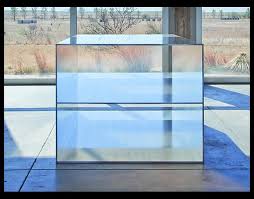
Jewel box!
Each box is unique. Some have little or no embellishment and others have interior walls, floating tops, slicing angles within. Seen from different perspectives, each is like a subtly changing jewel. One box (after a while, they don’t seem like “boxes” at all any more) offered up sharply delineated diamond shapes and hexagons, reflecting the raw landscape outside. Still others look like glass, prisms of yellow, gold, and silver. Slight defects on the surfaces due to the milling process have been left and add textural interest.
The intense desert heat and cold have caused some of the boxes to move slightly and the Chinati conservation team is working to realign them, after some debate about whether Judd would want any intervention at all in the natural process working on the sculptures. Ultimately, they determined that, as Judd had been so exacting about the precise distances between the boxes, and the symmetry in relation the building, he would want them adjusted.
If all this seems a bit precious, I assure you, it is not. The space, the objects, and the whole of the living piece fit stunningly into the rugged, flamboyant Texas landscape. Straightforward, simple, respectful of craftsmanship and material, fascinating in the mesmerizing effects of repetition and variation, these works simply could not exist elsewhere.
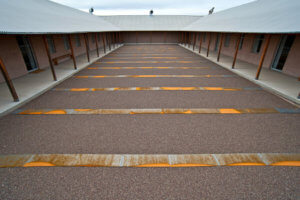
“Chinati Thirteener,” by Carl Andre
After seeing 48 more boxes in the smaller of the two buildings we moved on to see an installation by another minimalist, Carl Andre. “Chinati Thirteener” was installed in 2010 in the enclosed courtyard of a former dormitory building, now a temporary exhibition space. Playing off the posts that enclose the space, 13 strips of hot rolled steel plates are laid at intervals across an expanse of dark rock. While touching a Judd box would have sent the conservation team scurrying to clean it, here Andre invites the viewer to walk on the strips and enjoy the oxidized yellows and oranges blooming under your feet.
As we walked between the buildings, we were treated to a view in the distance of Judd’s longtime friend Claes Oldenburg’s “Monument to the Last Horse,” 1991, a tribute to Louie, the last of the cavalry horses.

“Last of the Cavalry Horses,” by Claes Oldenburg
Dan Flavin, another Judd friend, chose six former dormitory buildings in which to install fluorescent bulb sculptures in varying combinations of pink, green, blue, and yellow. When Dia funding ended, Judd and Flavin fell out and the project languished. Finally, financing was secured and the work was completed, opening in 2000. One can see similarities between Judd’s minimalism and Flavin’s—repetition, variations on themes, bringing in light from outside the dorm buildings— but at the same time, Flavin’s work is fanciful, far less austere than the Judd works. Trooping from building to building to see each configuration of bulbs and colors was fun and gave the experience an air of a treasure hunt.

Florescent Bulb Installation by Dan Flavin
John Chamberlain’s work is housed in a former mohair and wool storehouse in downtown Marfa. His metal work pieces left some on our tour group cold, if such a thing is possible in West Texas. Richard, having enjoyed the engineering marvels of the Judd boxes, was not impressed with Chamberlain’s squashed car sculptures and repaired to the vast muslin-draped object in the middle of the gallery known as “Barge Marfa,” 1983, where Elizabeth assured him he was welcome to lounge and watch Chamberlain’s romp of a film, “The Secret Life of Hernando Cortez,” 1968, in which Andy Warhol actors indulged in all forms of sybaritic behavior in a mysterious Mexican town. I found Chamberlain’s work to be wildly exuberant, especially when compared to the Zen-like refinement of Judd, and the shy playfulness of Flavin. His titles are marvelous too—“Small Monument to a Swiss Monument,” 1979-82—was my favorite. It writhes and dances and manages to stand only on three or four points with the agility of a sumo-wrestler crossed with dancer on pointe.
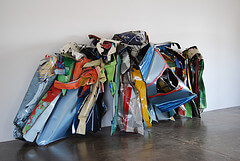
“Small Monument to a Swiss Monument,” by John Chamberlain
Back out on the streets of Marfa, we repaired to “Future Shark,” a cafeteria-style restaurant operated by the same chef who purveys marvelous food from the “Food Shark,” a food truck (one of several) parked under the farm market stalls near the (very active) railroad tracks. Here we ate one of the most beguiling vegetarian meals ever concocted. If this post has inspired you to make a similar pilgrimage (wait—I haven’t even told you about Prada Marfa! Stay tuned), you’ll find a number of world-class restaurants in this flat, unprepossessing town: Maiya’s and Cochineal for dinner, and Squeeze Marfa for breakfast. Either of the Sharks – any time.
Oh, and stay at the Hotel Paisano, named for a nearby mountain pass. After a long drive to Marfa, the margaritas in the plaza by the splashing fountain can’t be beat! It’s where the cast from “Giant” stayed. You can even stay in the Rock Hudson suite …
http://www.hotelpaisano.com/
 Following my last blog post on Donald Judd’s Chinati Foundation in Marfa, TX, we move on down the road to tiny ghost town, Terlingua. Once a thriving mercury mining town on the way to Big Bend National Park, Terlingua is now occupied by a few dozen living inhabitants who have moved into the falling down structures and rebuilt or expanded the shells of adobe brick.
Following my last blog post on Donald Judd’s Chinati Foundation in Marfa, TX, we move on down the road to tiny ghost town, Terlingua. Once a thriving mercury mining town on the way to Big Bend National Park, Terlingua is now occupied by a few dozen living inhabitants who have moved into the falling down structures and rebuilt or expanded the shells of adobe brick.
 One of the local cowboy types, now the manager of Terlingua’s Holiday Hotel, we overheard, strolled over to the group of hikers and, indicating the Hebrew letters of one of the young men’s tattoo, greeted him in fluent Hebrew. Turned out the young guy’s tattoo was “a mistake on my way to Iraq” and that he was not conversant, but our cowboy hotelier was raised in an orthodox family in Atlanta. Love it when our expectations are turned on their heads! We also met a young British couple visiting from Cambridge who were staying in the charming guest house attached to La Posada Milagro and described it as “shabby Texas chic.”
One of the local cowboy types, now the manager of Terlingua’s Holiday Hotel, we overheard, strolled over to the group of hikers and, indicating the Hebrew letters of one of the young men’s tattoo, greeted him in fluent Hebrew. Turned out the young guy’s tattoo was “a mistake on my way to Iraq” and that he was not conversant, but our cowboy hotelier was raised in an orthodox family in Atlanta. Love it when our expectations are turned on their heads! We also met a young British couple visiting from Cambridge who were staying in the charming guest house attached to La Posada Milagro and described it as “shabby Texas chic.”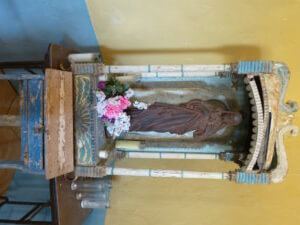 Grande and its “big bend” from Mexico.
Grande and its “big bend” from Mexico. The trading post was full of wonderful stuff. Here again, Mexico was vividly on display, with varied Day of the Dead artifacts everywhere. Disappointed not to have seen a local “javalina,” or collared peccary, a pig-like creature native to the Southwest, we consoled ourselves with this little fellow outside of the store.
The trading post was full of wonderful stuff. Here again, Mexico was vividly on display, with varied Day of the Dead artifacts everywhere. Disappointed not to have seen a local “javalina,” or collared peccary, a pig-like creature native to the Southwest, we consoled ourselves with this little fellow outside of the store.
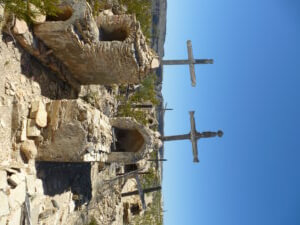 We lingered in the grave yard for easily an hour, fascinated by the touching, spooky, and inventive grave markers. Many are highly personal, with favorite belongings of the deceased arrayed beneath the markers.
We lingered in the grave yard for easily an hour, fascinated by the touching, spooky, and inventive grave markers. Many are highly personal, with favorite belongings of the deceased arrayed beneath the markers.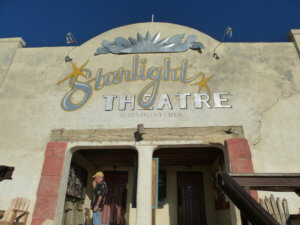 Featuring such delicacies as chicken-fried antelope with Lone Star Beer gravy and wild boar and venison sausage stuffed with jalapenos, the Starlight Theater and Restaurant clearly deserved a follow-up visit that night for dinner and some Texas two-step. Terlingua is the home of not one, but two “original” chili cook-offs, so we figured the chili would also world class. Not to mention all the local craft brews on tap. We were not disappointed.
Featuring such delicacies as chicken-fried antelope with Lone Star Beer gravy and wild boar and venison sausage stuffed with jalapenos, the Starlight Theater and Restaurant clearly deserved a follow-up visit that night for dinner and some Texas two-step. Terlingua is the home of not one, but two “original” chili cook-offs, so we figured the chili would also world class. Not to mention all the local craft brews on tap. We were not disappointed.







